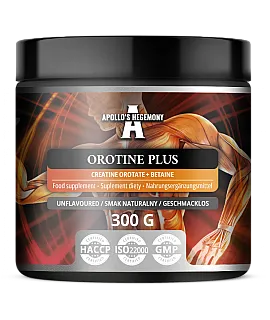Other forms of creatine
Creatine is one of the most popular dietary supplements among physically active people. It is available in a variety of forms that differ in assimilability, stability and effectiveness. In this category you will find information about less popular types of creatine, such as cre-alkaline or creatine orotate. Learn about their properties and find out which creatine you should choose to achieve the best results. Read more
Creatine orotate - an innovative form of creatine
Creatine orotate is a combination of a creatine molecule and orotic acid. Orotic acid is a compound present in organisms, mainly in muscle cells and liver, and is associated with nucleic acid metabolism. Creatine orotate is a niche and unique form of creatine, but one that has many supporters who return to it regularly after trying it.
Combining the two molecules together was designed to increase the body's absorption of creatine compared to other forms.
The average dosage used is about 5 grams of creatine orotate per day.
Kre-alkalyn - a buffered form of creatine
Kre-alkalyn is a special buffered form of creatine, developed to increase the stability and bioavailability of the supplement. Thanks to the buffering process, kre-alkalyn has a higher pH compared to the classic form, which prevents creatine from converting into its inactive form - creatinine.
Supplementation with kre-alkalyn can increase creatine levels in the muscles, resulting in improved exercise capacity during intense exercise. Kre-alkalyn is involved in energy processes, supporting the synthesis of ATP necessary for muscle work.
The recommended daily dose of Kre-alkalyn is about 3 g, taken before or after training. Due to its higher stability, cre-alkaline does not require a saturation phase like other forms.
Other forms of creatine - magnesium chelate, orotate, HCL
You can also find other, less popular forms of creatine on the market, such as creatine magnesium chelate and creatine HCL. Magnesium chelate of creatine is a combination of the creatine molecule with magnesium, which can affect better absorption and stability of the supplement.
Creatine HCL (creatine hydrochloride) is a form of creatine combined with a molecule of hydrochloric acid. This form of creatine has high stability and solubility, so it can be absorbed faster by the body. Creatine HCL can theoretically be used in lower doses compared to other forms, which reduces the risk of gastrointestinal side effects.
It is worth remembering that regardless of the form of creatine chosen, it is crucial to use the supplement regularly along with high-intensity exercise. Only then can you count on optimal results in the form of improved exercise capacity and muscle mass gain.
The most important information about the different forms of creatine is:
- Various forms of creatine are available, such as creatine orotate, cre-alkaline, magnesium chelate or creatine HCL.
- The different forms of creatine differ in bioavailability, stability and solubility.
- Creatine supplementation in various forms can improve exercise capacity during intense exercise.
- The recommended dosage depends on the form of creatine and usually ranges from 3 to 5 g per day.
- The effects of creatine are most noticeable when combined with high-intensity training.
